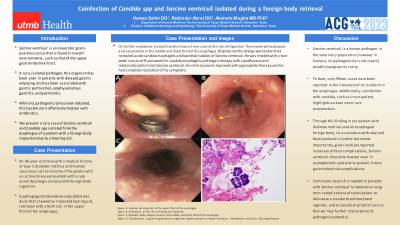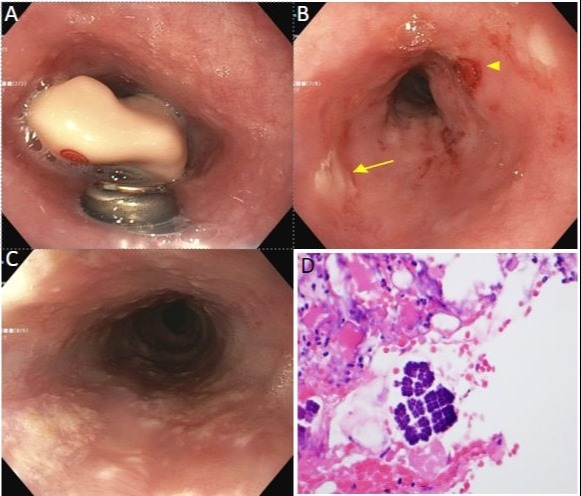Monday Poster Session
Category: Esophagus
P1862 - Coinfection of Candida spp and Sarcina ventriculi Isolated During a Foreign Body Retrieval
Monday, October 23, 2023
10:30 AM - 4:15 PM PT
Location: Exhibit Hall

Has Audio
- HS
Hamza Salim, DO
University of Texas Medical Branch
Galveston, TX
Presenting Author(s)
Hamza Salim, DO1, Robinder Abrol, DO1, Akshata Moghe, MD, PhD2
1University of Texas Medical Branch, Galveston, TX; 2UTMB, Galveston, TX
Introduction: Sarcina ventriculi is an anaerobic gram-positive coccus that is found in low pH environments, such as that of the upper gastrointestinal tract. A rare, isolated pathogen, this organism has been seen in patients with delayed gastric emptying and has been associated with gastric perforation, emphysematous gastritis, and peritonitis. While its pathogenicity has been debated, this bacterium is effectively treated with antibiotics. We present a rare case of Sarcina ventriculi and Candida spp isolated from the esophagus of a patient with a foreign body impaction due to a hearing aid.
Case Description/Methods: An 86-year-old male with a medical history of type 2 diabetes mellitus and treated squamous cell carcinoma of the glottis with no active disease presented with acute onset dysphagia and possible foreign body ingestion. He underwent esophagogastroduodenoscopy (EGD) that showed an impacted hearing aid, retrieved with a Roth net, in the upper third of the esophagus. On further evaluation, he was found to have a 5 mm ulcer at the site of impaction. There were white plaques and excoriations in the middle and distal third of the esophagus. Biopsies and brushings were taken that revealed acute candida esophagitis and bacterial isolates of Sarcina ventriculi. He was treated with a two-week course of fluconazole for candida esophagitis and began therapy with ciprofloxacin and metronidazole to treat sarcina. His clinical course improved with appropriate therapy and he had complete resolution of his symptoms.
Discussion: Sarcina ventriculi is a known pathogen in the veterinary population, however in humans, its pathogenicity is not clearly established given its rarity. To date, only fifteen cases have been reported in the literature of its isolation in the esophagus. Additionally, coinfection with candida, such as in our patient, highlights an even more rare presentation. Through this finding in our patient with diabetes mellitus and an esophageal foreign body, its association with retained food products is further bolstered. Importantly, given multiple reported instances of fatal complications, Sarcina ventriculi should be treated even in asymptomatic patients to prevent future gastrointestinal complications. Continued research is needed in patients with Sarcina ventriculi to determine long-term complications of colonization, to delineate a standardized treatment regimen, and to establish proof of cure so that we may further characterize its pathogenic potential.

Disclosures:
Hamza Salim, DO1, Robinder Abrol, DO1, Akshata Moghe, MD, PhD2. P1862 - Coinfection of Candida spp and Sarcina ventriculi Isolated During a Foreign Body Retrieval, ACG 2023 Annual Scientific Meeting Abstracts. Vancouver, BC, Canada: American College of Gastroenterology.
1University of Texas Medical Branch, Galveston, TX; 2UTMB, Galveston, TX
Introduction: Sarcina ventriculi is an anaerobic gram-positive coccus that is found in low pH environments, such as that of the upper gastrointestinal tract. A rare, isolated pathogen, this organism has been seen in patients with delayed gastric emptying and has been associated with gastric perforation, emphysematous gastritis, and peritonitis. While its pathogenicity has been debated, this bacterium is effectively treated with antibiotics. We present a rare case of Sarcina ventriculi and Candida spp isolated from the esophagus of a patient with a foreign body impaction due to a hearing aid.
Case Description/Methods: An 86-year-old male with a medical history of type 2 diabetes mellitus and treated squamous cell carcinoma of the glottis with no active disease presented with acute onset dysphagia and possible foreign body ingestion. He underwent esophagogastroduodenoscopy (EGD) that showed an impacted hearing aid, retrieved with a Roth net, in the upper third of the esophagus. On further evaluation, he was found to have a 5 mm ulcer at the site of impaction. There were white plaques and excoriations in the middle and distal third of the esophagus. Biopsies and brushings were taken that revealed acute candida esophagitis and bacterial isolates of Sarcina ventriculi. He was treated with a two-week course of fluconazole for candida esophagitis and began therapy with ciprofloxacin and metronidazole to treat sarcina. His clinical course improved with appropriate therapy and he had complete resolution of his symptoms.
Discussion: Sarcina ventriculi is a known pathogen in the veterinary population, however in humans, its pathogenicity is not clearly established given its rarity. To date, only fifteen cases have been reported in the literature of its isolation in the esophagus. Additionally, coinfection with candida, such as in our patient, highlights an even more rare presentation. Through this finding in our patient with diabetes mellitus and an esophageal foreign body, its association with retained food products is further bolstered. Importantly, given multiple reported instances of fatal complications, Sarcina ventriculi should be treated even in asymptomatic patients to prevent future gastrointestinal complications. Continued research is needed in patients with Sarcina ventriculi to determine long-term complications of colonization, to delineate a standardized treatment regimen, and to establish proof of cure so that we may further characterize its pathogenic potential.

Figure: Figure A: Hearing aid impacted in the upper third of the esophagus
Figure B: Ulcerations at the site of hearing aid impaction
Figure C: Multiple white plaques found in the middle and distal third of the esophagus
Figure D: Characteristic cuboid-shaped Sarcina organisms tightly packed in a tetrad formation. Hematoxylin and Eosin, 40x magnification.
Figure B: Ulcerations at the site of hearing aid impaction
Figure C: Multiple white plaques found in the middle and distal third of the esophagus
Figure D: Characteristic cuboid-shaped Sarcina organisms tightly packed in a tetrad formation. Hematoxylin and Eosin, 40x magnification.
Disclosures:
Hamza Salim indicated no relevant financial relationships.
Robinder Abrol indicated no relevant financial relationships.
Akshata Moghe indicated no relevant financial relationships.
Hamza Salim, DO1, Robinder Abrol, DO1, Akshata Moghe, MD, PhD2. P1862 - Coinfection of Candida spp and Sarcina ventriculi Isolated During a Foreign Body Retrieval, ACG 2023 Annual Scientific Meeting Abstracts. Vancouver, BC, Canada: American College of Gastroenterology.
